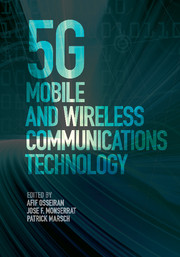Book contents
- Frontmatter
- Dedication
- Contents
- List of contributors
- Foreword
- Acknowledgments
- Acronyms
- 1 Introduction
- 2 5G use cases and system concept
- 3 The 5G architecture
- 4 Machine-type communications
- 5 Device-to-device (D2D) communications
- 6 Millimeter wave communications
- 7 The 5G radio-access technologies
- 8 Massive multiple-input multiple-output (MIMO) systems
- 9 Coordinated multi-point transmission in 5G
- 10 Relaying and wireless network coding
- 11 Interference management, mobility management, and dynamic reconfiguration
- 12 Spectrum
- 13 The 5G wireless propagation channel models
- 14 Simulation methodology
- Index
- References
2 - 5G use cases and system concept
Published online by Cambridge University Press: 05 June 2016
- Frontmatter
- Dedication
- Contents
- List of contributors
- Foreword
- Acknowledgments
- Acronyms
- 1 Introduction
- 2 5G use cases and system concept
- 3 The 5G architecture
- 4 Machine-type communications
- 5 Device-to-device (D2D) communications
- 6 Millimeter wave communications
- 7 The 5G radio-access technologies
- 8 Massive multiple-input multiple-output (MIMO) systems
- 9 Coordinated multi-point transmission in 5G
- 10 Relaying and wireless network coding
- 11 Interference management, mobility management, and dynamic reconfiguration
- 12 Spectrum
- 13 The 5G wireless propagation channel models
- 14 Simulation methodology
- Index
- References
Summary
In the 5G vision, access to information and sharing of data are possible anywhere and anytime to anyone and anything. 5G expands the usage of human-centric communications to include both human-centric and machine-centric communications. Mobile and wireless communication will increasingly become the primary way for humans and machines to access information and services. This will lead to socio-economic changes not yet imaginable, including improvements in productivity, sustainability, entertainment and well-being.
To make this vision a reality, the capabilities of 5G systems must extend far beyond those of previous generations. 5G systems must exhibit greater flexibility than previous generations, and involve farther-reaching integration including not only the traditional radio access networks, but also core network, transport and application layers. Altogether, this requires a new way of thinking in 5G wireless access, network architecture and applications.
In this chapter, first, the needs of the end users are described in terms of use cases and requirements, and then an overview of the 5G system concept meeting these user needs is given.
Use cases and requirements
This section provides the vision based on the expected societal development toward the year 2020 and beyond from the end-user perspective described in Chapter 1. Concrete use cases that have specific goals and challenges are provided. To achieve the goals and to overcome the challenges, there are certain specific requirements for 5G systems to meet. A collection of diverse use cases gives a set of challenging requirements that have to be fulfilled by 5G systems. The material below is largely based on [1]–[8]. The technical solutions to address these requirements are then discussed in the later chapters of this book.
Use cases
In this section, the most relevant 5G use cases are presented. Further, the challenges and requirements for each of these are named. As mentioned in Chapter 1, 5G will become a cornerstone in many of the economic sectors. Table 2.1 shows as an example how the addressed use cases map onto the major economic sectors. It should be noted that the list of use cases is far from being exhaustive. Only the most relevant ones from technical and business perspective are given. Finally, some of the use cases can be considered as a set of use cases (e.g. smart city or public safety).
- Type
- Chapter
- Information
- 5G Mobile and Wireless Communications Technology , pp. 21 - 49Publisher: Cambridge University PressPrint publication year: 2016
References
- 1
- Cited by

